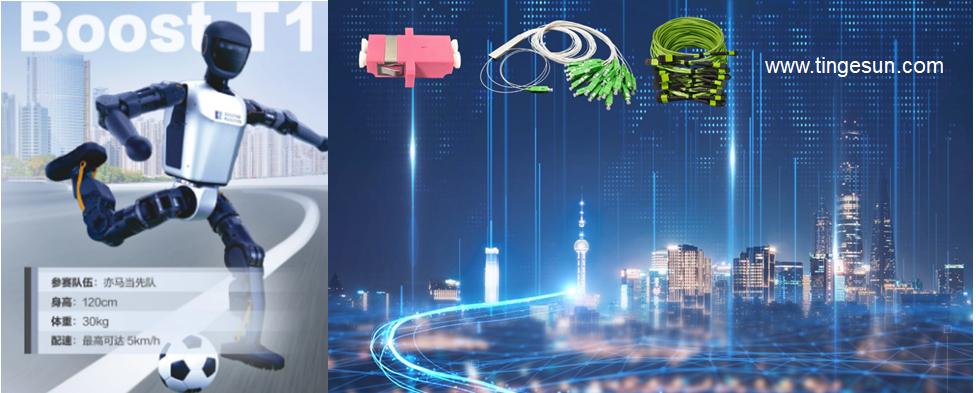


The recent inclusion of "embodied intelligence" in China’s Government Work Report marks a pivotal shift toward AI systems that interact dynamically with the physical world. From humanoid robots completing marathons to quadruped machines patrolling hazardous environments, these advancements rely on ultra-reliable, high-bandwidth communication networks to process real-time sensory data, execute AI-driven decisions, and ensure seamless human-robot collaboration. At the core of this technological leap lies fiber optic communication – the invisible nervous system enabling robots to "think" and "act" with precision.
1. Real-Time Sensor Fusion:
Modern robots integrate LiDAR, tactile sensors, and vision systems,
generating 2+ TB/hour of
data. Fiber optic networks provide the low-latency (<1 ms) and high-density bandwidth (400G+) required
for centralized AI processing and edge coordination.
For example, robots like Tiangong (the
marathon finisher) depend on uninterrupted data flow to adjust gait and balance
on uneven terrain.
2. Robustness in Dynamic Environments:
Industrial and outdoor robotic applications demand resistance to EMI,
temperature extremes (-40°C to +85°C), and mechanical stress. Armored fiber optic patch cords and ruggedized
connectors ensure zero
signal loss even in vibrating joints or extreme weather.
3. Scalability for Group Intelligence:
Collaborative robots (cobots) in smart factories rely on MPO/MTP trunk cables to
synchronize multi-agent systems. For instance, WalkerS1 robots at Geely’s 5G factory use
dense fiber arrays to achieve millimeter-level
coordination during assembly tasks.
To build the backbone of embodied AI, three types of optical passive devices are indispensable:
|
Component |
Role in Robotics |
Technical Requirements |
|
Fiber optic patch cords |
Connect sensors, controllers, and edge servers |
≤0.15dB insertion loss, 1000+plug cycles |
|
Optical Splitters |
Distribute data streams across robot clusters |
High uniformity (±0.5dB), low polarization dependency |
|
Fiber Adapters |
Enable modular system upgrades |
Precision ceramic sleeves, <0.2μm alignment tolerance |
Case in Point:
In power grid inspections, robots equipped with multi-modal sensors use FTTA (Fiber-to-the-Antenna) assemblies
to transmit thermal imaging and vibration data to control centers, reducing
inspection time by 2x.
As a leading manufacturer of fiber optic passive components, we TING ESUN empower embodied intelligence through:
1. Robotic-Grade Fiber optic patch cords:
o Military-Grade Durability: Bend-insensitive fibers withstand 10,000+ flex cycles in robotic joints.
o Customization: SC/LC/MPO connectors tailored for compact spaces (e.g., robotic limbs).
2. High-Performance Splitters & Adapters:
o PLC Splitters: 1xN configurations for distributed AI processing, ensuring <0.3dB uniformity.
o Ceramic Sleeve Adapters: Nano-level alignment accuracy for zero-error data transmission.
3. End-to-End Solutions:
o Anti-Vibration Kits: Secure connections in dynamic environments (e.g., drones, exoskeletons).
Any interest in fiber optic products, please contact sales@tingesun.com.